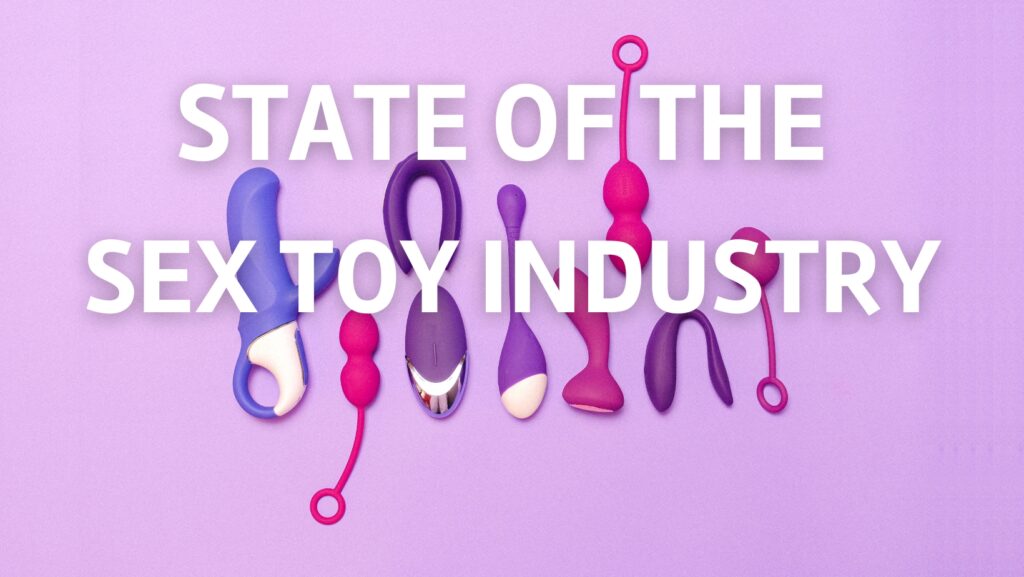How active are men sexually today? This report sheds light on the intimate lives of men, revealing how many have been inactive over the past year and the changing patterns of sexual activity from 1989 to 2021. We also explore trends in multiple partnerships and the factors influencing men’s sexual behavior. Unpack these statistics with us as we delve into what drives the sexual dynamics of men in modern society.
Here are the headings:
- Percent of men who have not had sex in the past 12 months
- How sexually active have men been since 1989 to 2021
- Men’s sexual activity with multiple partners
- Percent of sexual active men
- Factors Affecting Sexual Activity in Men
Key Insights
- 12 percent of men had sex once or twice in the past year.
- 19 percent of men did not have sex in the past year (down from 21 percent in 2018).
- In comparison, 32 percent of women reported sexual inactivity.
- 16 percent of men had sex on average once a month.
- 52 percent of men report having sex at least once a month or more.
- 17 percent of men report having sex two to three times a month.
- 36 percent of men have sex on average once a week or more.
Percent of men who have not had sex in the past 12 months (year)
In the following, we show the graphical depiction, as well as tabulated data on the men who report not having had sex in the past 12 months (and additionally, compare it to women).
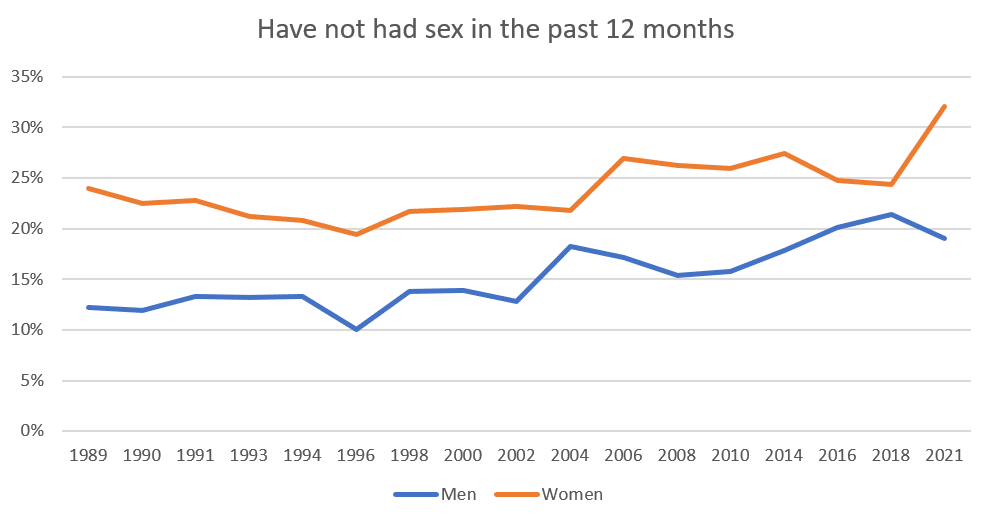
The answer therefore is that:
- 19 percent of men have not been sexually active in the past 12 months.
This is down from 21 percent in 2018, and 20 percent in 2016. However, the percentage of men who report being sexually inactive has not been higher since 1989.
Compared to women, however, men report on average to be more sexually active. The percentage of sexually inactive women has risen to an all-time high of 32 percent.
Here are the tabulated results from the two graphs:
| Have not had sex in past 12 months, by years reported | All | Men | Women |
|---|---|---|---|
| 1989 | 22% | 12% | 24% |
| 1990 | 20% | 12% | 23% |
| 1991 | 23% | 13% | 23% |
| 1993 | 22% | 13% | 21% |
| 1994 | 21% | 13% | 21% |
| 1996 | 19% | 10% | 19% |
| 1998 | 22% | 14% | 22% |
| 2000 | 22% | 14% | 22% |
| 2002 | 23% | 13% | 22% |
| 2004 | 21% | 18% | 22% |
| 2006 | 26% | 17% | 27% |
| 2008 | 25% | 15% | 26% |
| 2010 | 25% | 16% | 26% |
| 2014 | 26% | 18% | 27% |
| 2016 | 26% | 20% | 25% |
| 2018 | 27% | 21% | 24% |
| 2021 | 29% | 19% | 32% |
How sexually active have men been since 1989 to 2021
The proportion of men, who report having sex once a month or more has fallen from 72 percent in 1989 to 53 percent in 2021.
A drop of almost -20 percent in just 3 decades.
In other words, 20% of men are significantly less sexually active today, compared to 30 years ago.
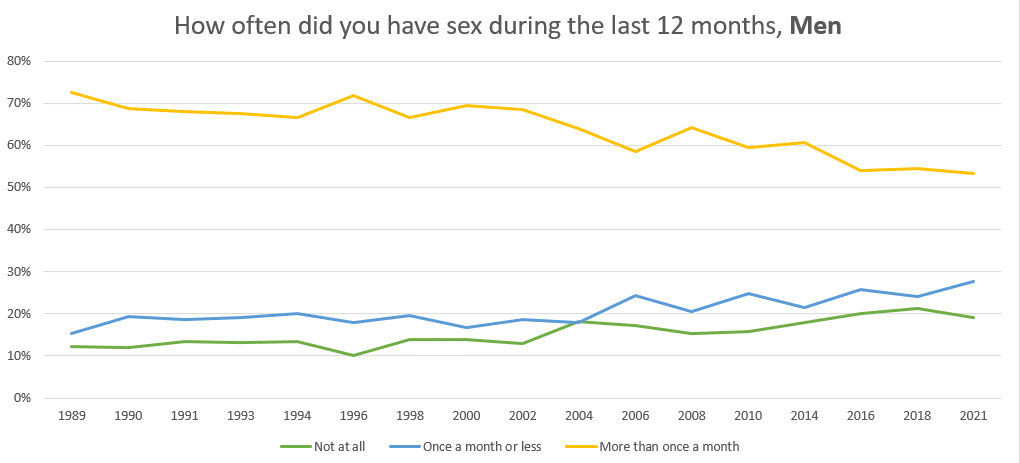
Again, the tabulated data for each survey year is represented below:
| Sex past 12 months, Men, Survey Year | Not at all | Once a month or less | More than once a month |
|---|---|---|---|
| 1989 | 12% | 15% | 72% |
| 1990 | 12% | 19% | 69% |
| 1991 | 13% | 19% | 68% |
| 1993 | 13% | 19% | 68% |
| 1994 | 13% | 20% | 67% |
| 1996 | 10% | 18% | 72% |
| 1998 | 14% | 20% | 67% |
| 2000 | 14% | 17% | 69% |
| 2002 | 13% | 19% | 68% |
| 2004 | 18% | 18% | 64% |
| 2006 | 17% | 24% | 58% |
| 2008 | 15% | 20% | 64% |
| 2010 | 16% | 25% | 59% |
| 2014 | 18% | 21% | 61% |
| 2016 | 20% | 26% | 54% |
| 2018 | 21% | 24% | 55% |
| 2021 | 19% | 28% | 53% |
Men’s sexual activity with multiple partners
Part of the GSS dataset includes data on the reported number of sexual partners that respondents have had in the past year.
For the first survey year ever, the percentage of men who have been with more than one sexual partner (in the past year) dropped below 15 percent.
In 2021 only 11 percent of men had more than one sexual partner in the past year.
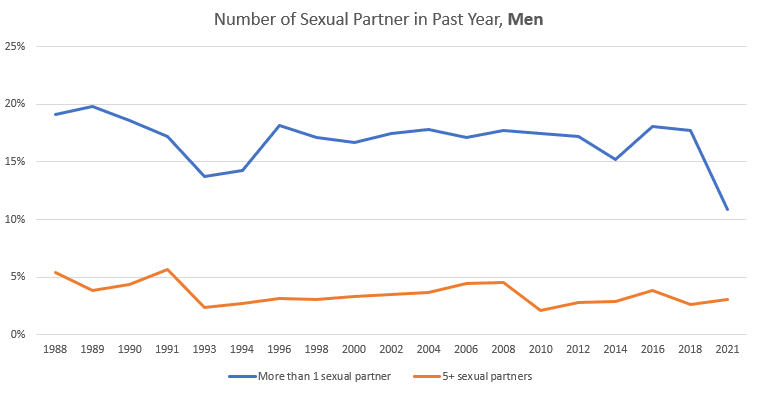
As visible from the graph, this number did not change for men reporting to be with 5 or more sexual partners in the past year. 3 percent of men reported to have been with 5 or more sexual partners in the past year.
The data also shows, that there is a significant increase in the number of men who report only one sexual partner in the past year.
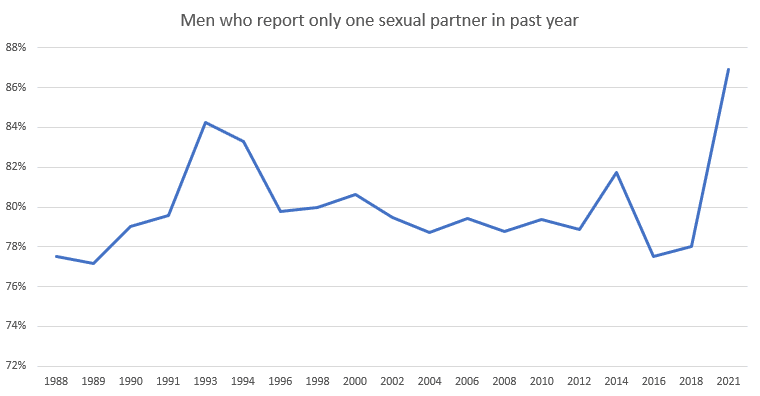
The tabulated data can be found below:
| Survey year | No sexual partner | Only 1 sexual partner | 1+ sexual partners | 5+ sexual partners |
|---|---|---|---|---|
| 1988 | 15% | 77% | 19% | 5% |
| 1989 | 13% | 77% | 20% | 4% |
| 1990 | 11% | 79% | 19% | 4% |
| 1991 | 16% | 80% | 17% | 6% |
| 1993 | 13% | 84% | 14% | 2% |
| 1994 | 15% | 83% | 14% | 3% |
| 1996 | 10% | 80% | 18% | 3% |
| 1998 | 14% | 80% | 17% | 3% |
| 2000 | 14% | 81% | 17% | 3% |
| 2002 | 15% | 79% | 17% | 3% |
| 2004 | 16% | 79% | 18% | 4% |
| 2006 | 17% | 79% | 17% | 4% |
| 2008 | 16% | 79% | 18% | 5% |
| 2010 | 15% | 79% | 17% | 2% |
| 2012 | 19% | 79% | 17% | 3% |
| 2014 | 17% | 82% | 15% | 3% |
| 2016 | 19% | 78% | 18% | 4% |
| 2018 | 19% | 78% | 18% | 3% |
| 2021 | 17% | 87% | 11% | 3% |
Percent of sexual active men
In sum, we find the following percentage of men reporting their sexual activity:
- 19 percent of men did not have sex at all in the past year.
- 12 percent of men had sex once or twice in the past year.
- 16 percent of men reported having sex once a month.
- 17 percent of men report having sex two to three times a month.
- 15 percent of men have sex on average once a week.
- 15 percent of men report having had sex on average two to three times a week in the past year.
- 6 percent of men say that they have sex more than three times a week.
Factors Affecting Sexual Activity in Men
Several factors can influence whether a man is sexually active, including:
- Age: As men age, the likelihood of sexual activity generally decreases. This decline can be due to various reasons, such as a drop in testosterone levels, the development of health issues, or changes in relationship status.
- Relationship status: Men in committed relationships are more likely to be sexually active compared to single men. Studies have shown that married or cohabitating men have higher levels of sexual activity than their single counterparts.
- Health: Overall health can significantly impact sexual activity. For example, conditions like erectile dysfunction, diabetes, and heart disease can all reduce sexual desire and performance.
- Mental health: Mental health issues like depression, anxiety, and stress can also contribute to reduced sexual activity.
- Socioeconomic factors: Education, income, and cultural background can all influence sexual activity, with higher levels of sexual activity typically reported among individuals with higher education and income.
Scientific studies look at male sexual activity
This section quickly summarizes the main findings of several studies that have explored various aspects of sexual activity, satisfaction, and associated factors in men across different age groups and cultural backgrounds.
The research discussed herein covers topics such as unwanted sexual activity, the prevalence of sexual behaviors, the impact of physical health and socioeconomic factors, and the decline of sexual interest with age.
Each sub-section highlights the primary finding of a specific study, offering a comprehensive overview of the existing knowledge on men’s sexual activity and satisfaction.
Men Experience Unwanted Sexual Activity
In a study conducted by Muehlenhard and Cook (1988), it was found that more men (62.7%) than women (46.3%) had experienced unwanted intercourse.
The research also revealed significant sex differences in the reasons for unwanted sexual activity and unwanted intercourse.
Reference: Muehlenhard, C., & Cook, S. (1988). Men’s self-reports of unwanted sexual activity. Journal of Sex Research.
Participants: 507 men and 486 women.
Majority of Men Aged 20-39 Have Had Vaginal Intercourse
Billy et al. (1993) discovered that 95% of men aged 20-39 had engaged in vaginal intercourse, with 23% having had 20 or more partners in their lifetime.
The study also found that the majority of men had performed and received oral sex, although at lower frequencies.
Reference: Billy, J., Tanfer, K., Grady, W., & Klepinger, D. (1993). The sexual behavior of men in the United States. Family planning perspectives.
Participants: 3,321 men.
One-third of Elderly Men Report Being Sexually Active
Hyde et al. (2010) found that approximately one-third of elderly men reported being sexually active.
Health problems like diabetes, depression, and medication use were associated with a lack of sexual activity.
Reference: Hyde, Z., Flicker, L., Hankey, G., Almeida, O., McCaul, K., Chubb, S. A., & Yeap, B. (2010). Prevalence of Sexual Activity and Associated Factors in Men Aged 75 to 95 Years. Annals of Internal Medicine.
Participants: 3,274 men.
Sexual Activity Declines After Age 60
Beutel et al. (2002) reported that sexual activity in men declines after the age of 60, with only 51% of men in this age group being sexually active.
The study also highlighted an age-related decline in sexual satisfaction and a slight increase in partnership satisfaction.
Reference: Beutel, M. E., Schumacher, J., Weidner, W., & Brähler, E. (2002). Sexual activity, sexual and partnership satisfaction in aging men—results from a German representative community study.
Participants: 1,299 men.
Elderly Men in Burkina Faso Remain Sexually Active
In a study by Kirakoya et al. (2019), 80.15% of elderly men in Burkina Faso had at least one sexual intercourse in a month. However, 82.44% of the participants noted a decline in libido.
Reference: Kirakoya, B., Kaboré, M., Fanéwendé Aristide Kabore, Paré, A., Mustapha, A., Ky Bienvenue Désiré, & Zango, B. (2019). Elderly Men Sexuality in Ouagadougou (Burkina Faso). Open Journal of Urology.
Participants: 200 men.
Lower Education Levels Predict Sexual Inactivity in Taiwanese Men
Liu et al. (2010) found that lower education levels, erectile dysfunction, loss of a partner, and increased comorbidities were independent predictors of sexual inactivity in middle-aged and elderly Taiwanese men.
Reference: Chia-Chu Liu, Hsu-Cheng Juan, Yung-Chin Lee, Wen-Jeng Wu, Chii‐Jye Wang, H. Ke, Wei‐Ming Li, H. Yeh, Ching-Chia Li, Y. Chou, Chun‐Hsiung Huang, & Shu-Pin Huang (2010). The impact of physical health and socioeconomic factors on sexual activity in middle-aged and elderly Taiwanese men.
Participants: 744 aging men.
Three-fifths of Adolescent Males Aged 15-19 Engaged in Sexual Intercourse
Sonenstein et al. (1991) reported that three-fifths of adolescent males aged 15-19 had engaged in sexual intercourse. The mean number of partners in the past year was 1.9, and the mean frequency of intercourse in the past month was 2.7 times.
Reference: Sonenstein, F., Pleck, J., & Ku, L. (1991). Levels of sexual activity among adolescent males in the United States. Family planning perspectives.
Participants: Adolescent males.
Sexual Interest and Activity Present in Older Men
Bergström‐Walan and Nielsen (1990) found that sexual interest and activity were present even in older ages. However, sexual interest and activity decreased significantly in the higher ages (75-80 years).
Reference: Bergström‐Walan, M., & Nielsen, H. H. (1990). Sexual expression among 60-80-year-old men and women:
Participants: A sample from Stockholm, Sweden.
Sexual Satisfaction Correlates Positively with Age in Male Nursing Home Residents
Mulligan and Palguta (1991) discovered that age, functional status, and intercourse frequency correlated positively with sexual satisfaction among male nursing home residents.
Reference: Mulligan, T., & Palguta, R. F. (1991). Sexual interest, activity, and satisfaction among male nursing home residents. Archives of sexual behavior.
Participants: 61 men.
The frequency of Sexual Daydreams Declines with Age
Giambra and Martin (1977) found that the frequency and intensity of sexual daydreams declined with increasing age, and after age 65, they virtually disappeared.
Reference: Giambra, L. M., & Martin, C. E. (1977). Sexual daydreams and quantitative aspects of sexual activity: Some relations for males across adulthood. Archives of sexual behavior.
Participants: 277 men.






